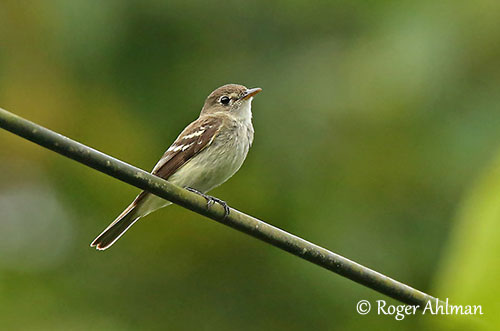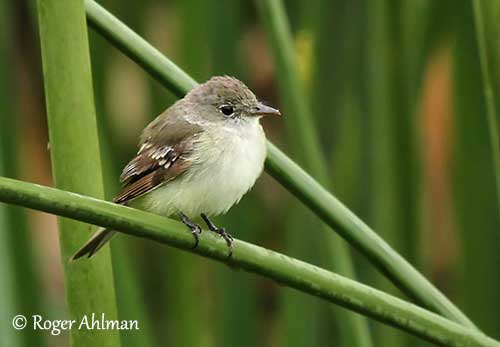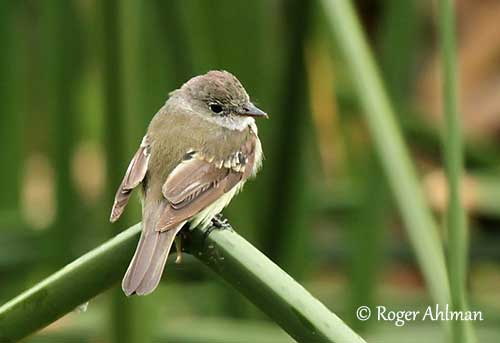
REPRODUCTION OF THIS SPECIES:
The breeding season is relatively short and occurs from mid-June to early August.
The nest, probably built by the female, is a loose cup-shaped structure made with grass, weeds, strips of bark, twigs and rootlets. It is lined inside with plant down or other soft materials. Some strips of bark or grass are sometimes dangling from the bottom.
The nest is placed in a fork of branch, usually in low deciduous shrub, about 60 to 180 centimetres above the ground.
The female lays 3-4 white eggs with brown spots and incubates alone during 12-14 days. The chicks are fed by both parents. The young fledge 13-14 days after hatching.
PROTECTION / THREATS / STATUS:
The Alder Flycatcher is common throughout the large range.
The population is estimated to number 49,000,000 individuals and is suspected to be stable.
The vegetation growing and replacing the cleared forest is beneficial for the species.
The Alder Flycatcher is not globally threatened and currently evaluated as Least Concern.
Fr: Moucherolle des aulnes
Ang: Alder Flycatcher
All: Erlenschnäppertyrann
Esp: Mosquero Alisero
Ita: Tiranno degli ontani
Nd: Elzenfeetiran
Sd: alempid
Photographer:
Roger Ahlman
Pbase Galleries Peru and Ecuador
Text by Nicole Bouglouan
Sources:
HANDBOOK OF THE BIRDS OF THE WORLD Vol 9 - by Josep del Hoyo - Andrew Elliot - David Christie - Lynx Edicions - ISBN: 8487334695
All About Birds (Cornell Lab of Ornithology)
The Birds of North America online
Wikipedia, the free encyclopaedia
What Bird-The ultimate Bird Guide (Mitchell Waite)
Alder Flycatcher
Empidonax alnorum
Passeriformes Order – Tyrannidae Family
INTRODUCTION:
The members of the genus Empidonax show fairly similar structure and plumage pattern, but the differentiation occurs mainly through voice and behaviour. These birds are always difficult to identify.
The Willow Flycatcher (Empidonax traillii) and the present species the Alder Flycatcher (Empidonax alnorum) utter distinctive songs across their ranges, either “fitz-bew” for the first one or “fee-bee-o” for the Alder Flycatcher. Each bird sings only once and does not respond to song of the other type.
There are differences also in habitat, nesting habits and distribution between birds with almost similar plumage characteristics.
Numerous Empidonax species are widespread in North and Middle America. Some of them have more restricted range.
The Alder Flycatcher is a small, fairly dull flycatcher that breeds in the northern part of North America and winters in W South America. It feeds primarily on insects, but it also takes fruits and seeds during winter.
It nests in a loose cup built in low trees or shrubs by the female. The clutch usually contains 3-4 eggs.
The Alder Flycatcher is described as common throughout the large range, and the species is not globally threatened for the moment.

DESCRIPTION OF THE BIRD:
Biometrics:
Length: 13-17 cm
Weight: 12-14 g
The Alder Flycatcher has dull greyish-olive upperparts. The upperwing is blackish with two conspicuous whitish to pale yellowish wingbars. Secondaries and tertials are edged whitish to pale yellowish, forming a panel on secondaries on closed wings. The tail is dark brown to blackish.
On the underparts, the throat is white. The breast is washed brownish-olive, darker on the sides. Belly and undertail-coverts are tinged pale yellow, more conspicuous in spring.
The plumage varies as it is more or less worn. Wingbars and margins are narrower in late summer.
On the head, the crown is slightly darker than upperparts. The narrow, indistinct lores are very pale, and there is a whitish eyering. Rest of head is dull olive.
The two-tone bill has black upper mandible and pale orange-yellow lower mandible. The eyes are dark brown. Legs and feet are blackish.
Male and female are similar.
The immature has browner upperparts. The wingbars are broader and yellowish-buff.
RANGE:
The Alder Flycatcher breeds in most of Canada and Alaska, but the breeding range descends to a southernmost point in NE USA.
The range includes W Alaska S to SC British Columbia, and E to Canadian Maritime provinces, and from Great lakes E in USA to New England, and S to Indiana, Ohio, in Appalachians to North Carolina.
The species winters in W South America, from NW Venezuela, Colombia and E Ecuador, S to E Peru and N and E Bolivia. Maybe also in E Panama and N Argentina.

HABITAT:
The Alder Flycatcher breeds in patches of deciduous trees and shrubs, and often near water, around streams and ponds. It favours mainly the thickets of willows and alders. It breeds from sea-level to 1,300 metres of elevation.
During winter, it occurs mainly at forest edges or in second growths, always near water. It usually occurs around 1,100 metres of elevation.
CALLS AND SONGS: SOUNDS BY XENO-CANTO
The Alder Flycatcher is usually identified by its song.
The most common call is a short note “pip”, “tip”, “peep” or “whit”. The Wee-oo” call is longer and louder with buzzing end.
The song is a buzzy “fee-bee-o” dropping in pitch on “o”.
These birds produce bill-snapping during aggressive encounters. They sing more frequently in morning and evening.
BEHAVIOUR IN THE WILD:
The Alder Flycatcher feeds mainly on insects such as wasps, bees, winged ants, beetles, flies, caterpillars, moths and others.
The diet also includes some spiders and occasionally berries and seeds.
It hunts from perch, searching for prey by sight and then, flying off to catch it. It forages among tall shrubs and low trees.
Insects are caught in mid-air or by hovering in front of foliage.
During the breeding season, the male sings to defend the territory. The courtship displays are poorly known, but chases through the trees between male and female probably occur.
The cup-shaped nest is often placed in low shrub, between 60 and 180 centimetres above the ground.
The Alder Flycatcher is a long-distance migrant. They migrate at night to reach South America.
They leave the breeding grounds in late August, passing through Mexico and N Central America in August/September and through Costa Rica from late August to early November.
They leave the wintering grounds from March to early May.
The Alder Flycatcher has weak, fluttering, direct flight with shallow wingbeats.
